SEMA News—August 2020
LEGISLATIVE AND TECHNICAL AFFAIRS
Pouring Salt to Heal Old Wounds
 Attempting to set a land-speed record as the sun rises on the Bonneville Salt Flats. Photo courtesy: LandSpeed Productions |
“Make Bonneville Great Again” is no longer just a cheeky slogan that land-speed racers have printed on hats. SEMA is proud to announce that a joint state/federal program to save the Bonneville Salt Flats has been created to dramatically increase the amount of salt pumped onto those hallowed grounds.
The “Restore Bonneville” program is now officially being implemented by the Utah Department of Natural Resources (DNR) in coordination with the U.S. Bureau of Land Management (BLM). The state of Utah and Congress have both approved funding to kick off the effort. The agencies have signed a memorandum of understanding that outlines the shared interest and commitment of BLM and DNR to work together to manage and restore the salt flats.
Located near Wendover on the Utah/Nevada border, the Bonneville salt basin covers an area about 65 mi. long and 25 mi. wide. It is the densely packed salt remnants of an ancient lake bed that formed over thousands of years. Bonneville’s stark and beautiful landscape has been the backdrop for movies, commercials and photos, and it is a magnet for tourists.
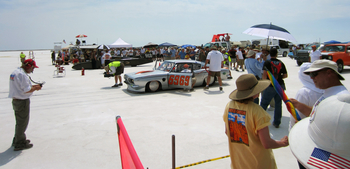 Last-minute vehicle checks at the starting line. Photo courtesy: Team Vesco |
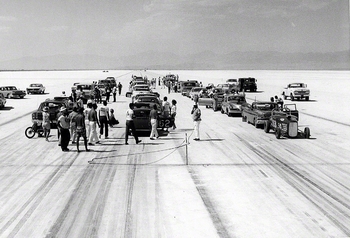 A vintage racing photo from 1966. |
The salt flats have been hallowed grounds for motorsports enthusiasts since 1914, when racers discovered that it was the perfect surface for keeping tires cool and setting land-speed records. While hundreds of records have been set and broken in a variety of automotive classes, the conditions at Bonneville have deteriorated since the ’60s.
Racers were once able to compete on a 13-mi. racetrack at Bonneville, but race sanctioning bodies are now unable to find more than 8 mi. of straightaway. Racing in two opposite directions within one hour has traditionally been required for world records, but that rule has been largely abandoned. The racecourse at Bonneville is not currently long enough for the world’s fastest vehicles to compete. While the conditions at Bonneville have deteriorated significantly over the past few decades, SEMA and the racing community have created a pathway for it to again become a preeminent race venue.
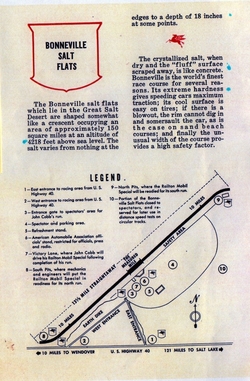 A 1947 Speed Week brochure, which includes a map of the 13½-mi. straightaway. |
The Bonneville Salt Flats Racetrack is listed on the National Registry of Historic Places and designated an Area of Critical Environmental Concern and a Special Recreation Management Area. Despite those designations, the salt crust has steadily deteriorated to a maximum thickness measured in inches rather than feet.
Interstate 80 divides the Bonneville basin in half. To the north is a racing venue; to the south is a potash mining operation. The two activities existed in harmony until the ’60s, when the BLM issued leases allowing some of Bonneville’s salt to be legally transferred south through miles of ditches. Potash is extracted from the salt through solar evaporation, and the salt is a waste product of the process.
For decades, the land-speed racing community sounded the alarm that Bonne-ville was shrinking. No tangible response occurred until 1997, when the racing community worked with the mine owner and the BLM on a five-year pilot program to pump the processed salt brine onto Bonneville during the winter months. An average of 1.2 million tons of salt a year were transferred during that time.
Studies confirmed that Bonneville’s salt crust began to thicken, and the brine aquifer beneath the surface also improved. In more recent years, however, the pumping levels have been around 0.3 to 0.6 million tons or less—not enough to change Bonneville’s status as endangered.
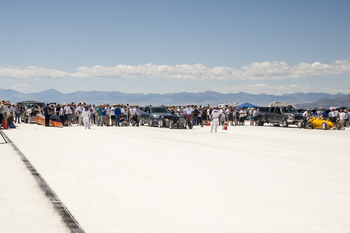 A 2009 photo of three different types of vehicles at the starting line (from left), the Speed Demon streamliner, the Dripps & Gibby Racing roadster, and the Kelly & Hall belly tank. Photo courtesy: LandSpeed Productions |
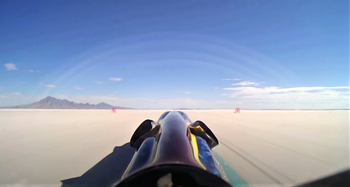 A view from Dave Spangler’s driver’s seat in the Turbinator II which will exit the 2018 racing venue at 503 mph and become the world’s fastest wheel-driven vehicle. |
SEMA, the Save the Salt Coalition and other organizations and companies seeking to restore Bonneville have worked closely with government officials and the mine owner, Intrepid Potash, to create an expanded 10-year salt-pumping program. An agreement has been signed, and the program details are being finalized.
Building on the success of the earlier 1997–2002 initiative, the upcoming 10-year Restore Bonneville program will increase the volume of salt to be pumped to 1 million tons per year or more. Program results will be closely monitored and analyzed over the 10-year period, with the intent of making it a permanent program. Listed below are highlights of the Restore Bonneville program.
- The program will be funded through annual appropriations from the BLM and the state of Utah.
- Over the next two or three years, Intrepid will increase its pumping volumes by making infrastructure upgrades, including but not limited to rebuilding wells, relining and covering water ditches, relining processing ponds, and installing new pipes and pumps.
- The overall cost of the program will be around $50 million over 10 years. The bulk of the money will come from federal and state appropriations, but the racing community will make meaningful contributions as well, and Intrepid will donate the value of the salt.
- Congress appropriated up to $4 million for Restore Bonneville in fiscal year 2020, and the Utah State Legislature approved $1 million for this year to create the program.
- SEMA and the Save the Salt Coalition will continue to work with the U.S. Congress, Trump Administration and state of Utah to continue funding and implementing the program.
| SEMA and Bonneville | Want to Help a Treasured Speedway | |||||||
SEMA’s roots are firmly planted at Bonneville. Member products and sponsored race teams have helped set scores of world records on the naturally occurring racetrack. When SEMA was formed in 1963, the then-titled Speed Equipment Manufacturers Association represented companies producing performance equipment for many land-speed trailblazers. In subsequent years, the industry blossomed, and the renamed Specialty Equipment Market Association expanded beyond the race and performance markets to embrace the entire distribution chain, including manufacturers, distributors, retailers and marketers. Founding SEMA members such as Ansen, B&M, Cragar, Edelbrock, Eelco Manufacturing, Grant Industries, Halibrand, Hedman, Isky Racing Cams, JE Pistons, Milodon, Mooneyes, Schiefer Manufacturing, Trans-Dapt, Weber Speed Equipment and Weiand have been joined by scores of other companies that produce high-performance parts. Whether it is a ’32 hot rod, a ’60s musclecar, a streamliner or anything in between, Bonneville has long been the proving ground for many SEMA-member companies and their customers. | The Save the Salt Foundation is a 501(c)(3) nonprofit organization whose mission is to protect the Bonneville Salt Flats and to promote its history and motorsports legacy. Funds collected by the foundation will be applied only to the 10-year Bonneville restoration program. Contributions are deductible to the extent allowed by law. |






